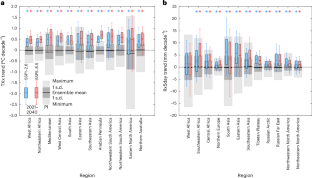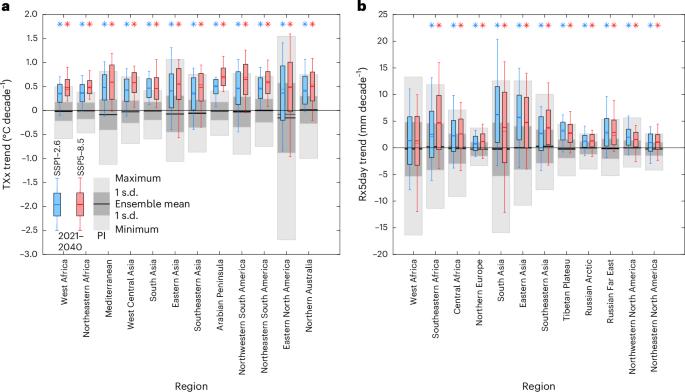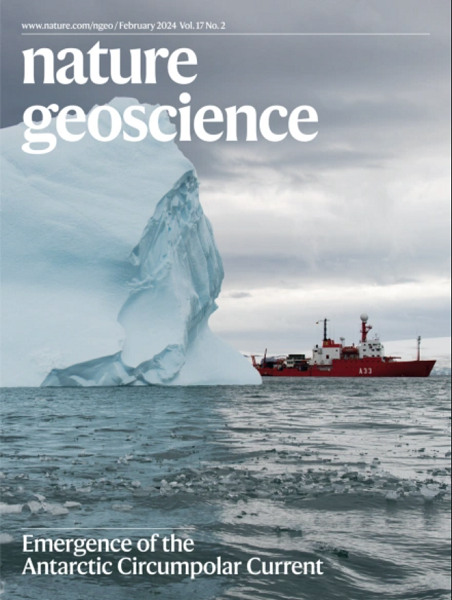高排放和低排放路径下未来二十年极端天气的强烈区域趋势
IF 15.7
1区 地球科学
Q1 GEOSCIENCES, MULTIDISCIPLINARY
引用次数: 0
摘要
全球变暖正在迅速改变气候条件,使之偏离社会和生态系统所适应的状况。虽然人们对平均气候和极端气候的变化幅度进行了广泛研究,但作为气候风险主要驱动因素的区域变化率却较少受到关注。在这里,我们利用大型集合气候模型模拟结果表明,在高排放情景下,预计在未来 20 年内,热带和亚热带的大部分地区(包括目前全球 70% 的人口)将经历强烈的温度和降水极端事件联合变化率(>2 s.d.),而在强烈的排放减缓情景下,这一变化率将下降到 20%。这主要是气温极端变化,相对于工业化前时期,世界大部分地区的气温极端变化率都不寻常(1 s.d.),但北部高纬度地区、亚洲南部和东部以及赤道非洲的降水极端变化也不寻常。然而,20 年趋势的内部变异性很高,这意味着在短期内,极端降水量仍有可能出现相反的趋势,极端气温虽然罕见,但并非不可能。我们还发现,气溶胶排放的快速清除(主要是在亚洲上空)会导致极端暖流在同一地点加速增加,并影响亚洲夏季季风。本文章由计算机程序翻译,如有差异,请以英文原文为准。


Strong regional trends in extreme weather over the next two decades under high- and low-emissions pathways
Global warming is rapidly shifting climate conditions away from what societies and ecosystems are adapted to. While the magnitude of changes in mean and extreme climate are broadly studied, regional rates of change, a key driver of climate risk, have received less attention. Here we show, using large ensembles of climate model simulations, that large parts of the tropics and subtropics, encompassing 70% of current global population, are expected to experience strong (>2 s.d.) joint rates of change in temperature and precipitation extremes combined over the next 20 years, under a high-emissions scenario, dropping to 20% under strong emissions mitigation. This is dominated by temperature extremes, with most of the world experiencing unusual (>1 s.d.) rates relative to the pre-industrial period, but unusual changes also occur for precipitation extremes in northern high latitudes, southern and eastern Asia and equatorial Africa. However, internal variability is high for 20 year trends, meaning that in the near term, trends of the opposite sign are still likely for precipitation extremes, and rare but not impossible for temperature extremes. We also find that rapid clean-up of aerosol emissions, mostly over Asia, leads to accelerated co-located increases in warm extremes and influences the Asian summer monsoons. Large-ensemble simulations suggest that strong regional trends in precipitation and temperature extremes will be common over the next two decades, even under stringent mitigation measures.
求助全文
通过发布文献求助,成功后即可免费获取论文全文。
去求助
来源期刊

Nature Geoscience
地学-地球科学综合
CiteScore
26.70
自引率
1.60%
发文量
187
审稿时长
3.3 months
期刊介绍:
Nature Geoscience is a monthly interdisciplinary journal that gathers top-tier research spanning Earth Sciences and related fields.
The journal covers all geoscience disciplines, including fieldwork, modeling, and theoretical studies.
Topics include atmospheric science, biogeochemistry, climate science, geobiology, geochemistry, geoinformatics, remote sensing, geology, geomagnetism, paleomagnetism, geomorphology, geophysics, glaciology, hydrology, limnology, mineralogy, oceanography, paleontology, paleoclimatology, paleoceanography, petrology, planetary science, seismology, space physics, tectonics, and volcanology.
Nature Geoscience upholds its commitment to publishing significant, high-quality Earth Sciences research through fair, rapid, and rigorous peer review, overseen by a team of full-time professional editors.
 求助内容:
求助内容: 应助结果提醒方式:
应助结果提醒方式:


